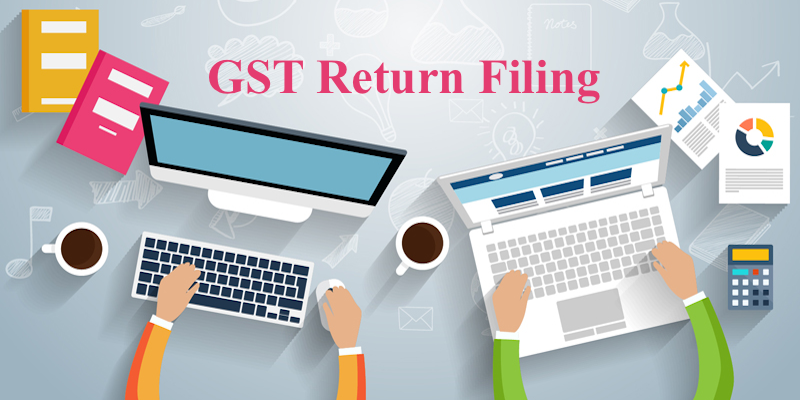A GST return is a document containing details of all income/sales and/or expenses/purchases that a GST-registered taxpayer (every GSTIN) is required to file with the tax administrative authorities. This is used by tax authorities to calculate net tax liability.
Under GST, a registered dealer has to file GST returns that broadly include:
- Purchases
- Sales
- Output GST (On sales)
- Input tax credit (GST paid on purchases)
Businesses that are registered under GST have to file the GST returns monthly, quarterly, and annually based on the business. Here it is necessary to provide the details of the sales or purchases of the goods and services along with the tax that is collected and paid. Implementation of a comprehensive Income Tax System like GST in India has ensured that taxpayer services such as registration, returns, and compliance are in range and perfectly aligned.
An individual taxpayer filing the GST returns has to file 4 forms for filing the GST returns such as the returns for the supplies, returns for the purchases made, monthly returns, and the annual returns.
GST return filing in India is mandatory for all the entities that have a valid GST registration irrespective of the business activity or the sales or the profitability during the period of filing the returns. Hence, even a dormant business that has a valid GST registration must file the GST returns.

Who should file GST Returns?
GST Return filing in India is to be done by the following:
- A person having a valid GSTIN has to compulsorily file the GST returns.
- Also, a person whose annual turnover is crossing Rs. 20 lakh has to obtain a GST registration and file the GST returns mandatorily.
- In the cases of Special states, the limit for the annual turnover is Rs.10 lakh.
Types of GST Registration
What are the different types of GST registration in India?
- GSTR 1- Details of the outward supplies of the taxable goods and or services
- GSTR 3B-Simple returns in which a summary of the outward supplies along with the input tax credit that is declared and the payment of the tax is affected by the taxpayer.
- CMP 08-Statement cum challan to make a tax payment by a taxpayer registered under the composition scheme under Section 10 of the CGST Act.
- GSTR 4-Returns to be filed by the taxpayer that is registered under the composition scheme under Section 10 of the CGST Act
- GSTR 5-Returns to be filed by a Non-resident taxable person
- GSTR 6-To be filed by the input service distributor to distribute the eligible input tax credit
- GSTR 7-Is filed by the government authorities
- GSTR 8-Details of supplies that are affected through the e-commerce operators and the amount of tax that is collected at the source by them.
- GSTR 9-Annual return for a normal taxpayer
- GSTR 9C-Certified reconciliation statement
- GSTR 10-Is filed by the taxpayer whose GST registration is canceled
- GSTR 11-Details of the inward supplies are furnished by a person who has UIN and also claims a refund.
Documents Required for GST Return Filing
- Invoices issued to persons with GSTIN or B2B invoices
- Invoices issued to persons without GSTIN or B2C invoices
- This needs to be submitted only when its total value is above ₹2.5 lakhs
- A consolidation of inter-state sales
- HSN-wise summary of all goods sold
- Any other debit or credit notes or advance receipts
How to File GST Returns?
Step 1: Visit the GST portal (www.gst.gov.in).
Step 2: A 15-digit GST identification number will be issued based on your state code and PAN number.
Step 3: Upload invoices on the GST portal or the software. An invoice reference number will be issued against each invoice.
Step 4: After uploading invoices, outward return, inward return, and cumulative monthly return have to be filed online. If there are any errors, you have the option to correct it and refile the returns.
Step 5: File the outward supply returns in GSTR-1 form through the information section at the GST Common Portal (GSTN)
Step 6: Details of outward supplies furnished by the supplier will be made available in GSTR-2A to the recipient.
Step 7: Recipient has to verify, validate, and modify the details of outward supplies, and also file details of credit or debit notes.
Step 8: Recipient has to furnish the details of inward supplies of taxable goods and services in GSTR-2 form.
Step 9: The supplier can either accept or reject the modifications of the details of inward supplies made available by the recipient in GSTR-1A.
What is the penalty for the late filing of GST returns?
f you have failed to pay the GST returns, there is an interest and late fee to be paid. The interest is at 18% per annum to be calculated on the amount of outstanding tax. And under the CGST and SGST, there is a late fee of Rs.100 to be paid each day, so the total comes to Rs.200 per day.
GST Return Filing in india FAQ's
1. What Happens If I Miss the Deadline?
Missing GST return filing deadlines can lead to penalties and late fees. It’s crucial to file your returns on time to avoid unnecessary financial burdens.
2.What Documents Do I Need for GST Return Filing?
To file your GST return, you’ll need invoices, debit notes, credit notes, and other relevant documents. Ensure that all these documents are accurate and in line with the GST law.
3.What is difference between GSTR-3 and 3B?
GSTR-3 is a more comprehensive form that requires businesses to provide detailed information related to their sales and purchases, whereas GSTR-3B is a simplified form that requires only basic information.
